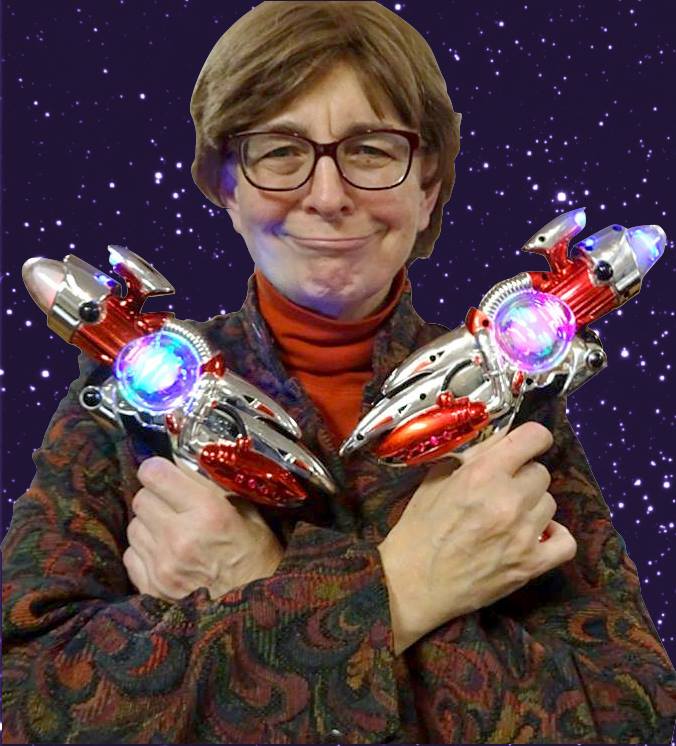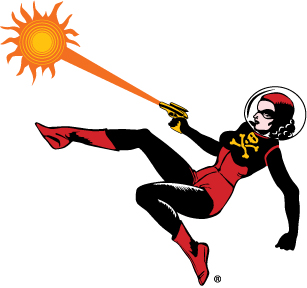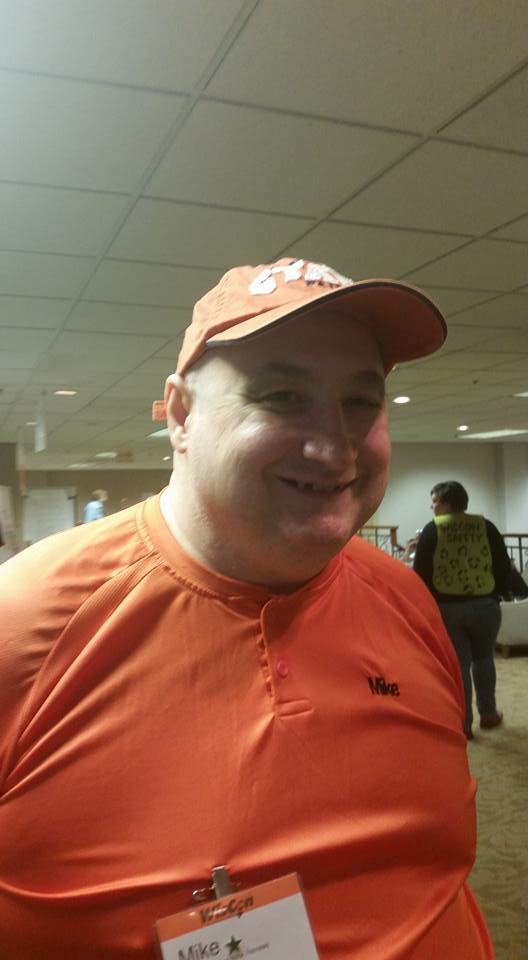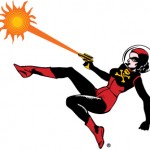(1) WHILE YOU WERE WAITING. Ann Leckie must be wondering if any of us are paying attention.
Quite frequently someone at a reading will ask me if I’ll ever explain about that icon Breq is carrying. And the answer is, I already have.
(2) JUST SAY THANKS. Joe Vasicek has some intriguing “Thoughts on series and perma-free”.
For the last five years, the conventional wisdom among most indie writers has been to write short books in sequential series and make the first book permanently free. It’s a strategy that works, to a certain extent. It’s what got me from making pizza money on my book sales to making a humble living at this gig. However, I’m starting to question that wisdom….
….Also, when you have a book that’s permanently free, it tends to accumulate a lot of negative reviews. It’s strange, but some people seem to feel more entitled to XYZ when they get it for free, as opposed to paying for it. Or maybe these are the people who try to go through life without actually paying for anything? Who hoard everything, even the stuff that they hate, so long as they can get it for free? I don’t know.
Certainly, that’s not true of everyone who reads free books. But when you have a perma-free book, it tends to accumulate more of the barely-coherent “dis buk sux” kinds of reviews from people who probably weren’t in the target audience to begin with. And over time, that tends to weigh the book’s overall rating down, which unfortunately can be a turn-off for people who are in the book’s audience.
(3) TIPTREE AUCTION. Here’s an advance look at an item in the Tiptree Auction at WisCon.
On Saturday, May 28, fans of the Tiptree Award will have the opportunity to bid on a genuine blaster that was once the sidearm of Space Babe, a legendary feminist superhero. (Blaster is modeled here by a Space Babe impersonator). This rare item will be part of the annual Tiptree Award Auction, to be held at at WisCon in Madison Wisconsin….
(4) MANCUNICON. Starburst brings you Ed Fortune’s 2016 Eastercon report.
Event highlights included interviews with the Guest of Honour John W. Campbell Award-winning novelist Aliette de Bodard, Hugo Award-winning author Ian McDonald, British Fantasy Award-winning creator Sarah Pinborough, and noted astrophysicist David L. Clement. Each drew a huge crowd, and coloured the event in their own unique way. Notably, Clement spearheaded a science-heavy approach to many of the panel items, and many of the talks centred on science and Manchester’s iconic research centre, Jodrell Bank. The iconic building, which has inspired many works of science fiction throughout its history, was thoroughly explored in many talks and lectures.
(5) NUMBER FIVE. Nina Munteanu, at Amazing Stories, continues the series — “The Writer-Editor Relationship, Part 2: Five Things Writers Wish Editors Knew – and Followed”.
- Edit to preserve the writer’s voice through open and respectful dialogue
Losing your voice to the “hackings of an editor” is perhaps a beginner writer’s greatest fear. This makes sense, given that a novice writer’s voice is still in its infancy; it is tentative, evolving, and striving for an identity. While a professional editor is not likely to “hack,” the fear may remain well-founded.
A novice’s voice is often tangled and enmeshed in a chaos of poor narrative style, grammatical errors, and a general misunderstanding of the English language. Editors trying to improve a novice writer’s narrative flow without interfering with voice are faced with a challenge. Teasing out the nuances of creative intent amid the turbulent flow of awkward and obscure expression requires finesse—and consideration. Good editors recognize that every writer has a voice, no matter how weak or ill-formed, and that voice is the culmination of a writer’s culture, beliefs, and experiences. Editing to preserve a writer’s voice—particularly when it is weak and not fully formed—needs a “soft touch” that invites more back-and-forth than usual, uses more coaching-style language, and relies on good feedback….
(6) KELLY LINK. Marion Deeds picked the right day to post a review of a Kelly Link story from Get in Trouble at Fantasy Literature.
“The Summer People” by Kelly Link (February 2016, free online at Wall Street Journal, also included in her anthology Get in Trouble)
“The Summer People” is the first story in Kelly Link’s new story collection Get in Trouble. Fran is a teenager living in a rural part of the American southeast. Her mother is gone, and she is neglected by her moonshiner father. While Fran is running a fever of 102 with the flu, her father informs her that he has to go “get right with God.” On his way out the door, he reminds her that one of the summer families is coming up early and she needs to get the house ready. However, that family isn’t the only group of summer people that Fran “does for,” and this is the point of Link’s exquisite, melancholy tale.
(7) HE’S FROM THE FUTURE. While Doctor Who can travel to anyplace and nearly any point in time, he invariably ends up in London. The Traveler at Galactic Journey seems likewise constrained always to arrive at the same opinion of John W. Campbell, although his fellow fans voted Analog a Hugo for this year’s work — “[April 18, 1961] Starting on the wrong foot”.
Gideon Marcus, age 42, lord of Galactic Journey, surveyed the proud column that was his creation. Three years in the making, it represented the very best that old Terra had to offer. He knew, with complete unironic sincerity, that the sublimity of his articles did much to keep the lesser writers in check, lest they develop sufficient confidence to challenge Gideon’s primacy. This man, this noble-visaged, pale-skinned man, possibly Earth’s finest writer, knew without a doubt that this was the way to begin all of his stories…
…if he wants to be published in Analog, anyway.
(8) ON MILITARY SF. SFFWorld interviews Christopher Nuttall.
Christopher Nuttall’s Their Darkest Hour has just been released as part of the Empire at War collection where four British Science Fiction authors have joined forces to show the world that British Military Science Fiction is a force to be reckoned with….
So what is different with British Military SF? Obviously in Their Darkest Hour you have the UK setting that probably will be more familiar to a Europeans than Americans, but do you also think there are other aspects where British authors are able to bring something different and unique to military SF?
I think that’s a hard question to answer.
There is, if you will, a cultural difference between American MIL-SF (and military in general) and British MIL-SF. Many American military characters (in, say, John Ringo’s work) are very forward, very blunt … I’d go so far as to say that most of them are thoroughly bombastic. Think a Drill Instructor screaming in your face. While a great many British characters are often calm, competent and basically just get the job done. We’re not as outwardly enthusiastic as the Americans; we’re more gritty endurance, stiff upper lip and just keep going until we win.
To some extent, I think that comes from our differing experiences. The Americans are staggeringly rich and, even as early as their civil war, had little trouble keeping their troops supplied. Britain, particularly in the years after 1919, had very real problems making ends meet, let alone keeping the troops supplied. We operate on a shoestring and know it. The Falklands was our most successful war in years, yet it was a very close run thing. We simply cannot afford to be as blatant as the Americans.
I think that is reflected in our SF too. Independence Day was followed by Invasion: Earth, a six-episode TV series set in Britain. Independence Day is blatant; the enemy is clearly visible, merely overwhelmingly powerful. Invasion: Earth has an enemy who hides in the shadows, at least up until the final episode. They both represent, too, a very different set of fears.
(9) OVER THE EDGE OF HISTORY. Jeff Somers considers “6 Historical Fiction Novels That Are Almost Fantasy” at B&N Sci-Fi & Fantasy Blog.
Hild, by Nicola Griffith Set in the so-called “Dark Ages,” after Rome abandoned Britain but before the squabbling kingdoms and tribes were unified under one crown, Griffith’s novel tells the true story of the Christian saint Hild, who would become Saint Hilda of Whitby, patron saint of learning. In 7th century Britain, she is the 6-year old niece of King Edwin of Northumbria, and becomes his seer and mystic upon arrival at his court. The reality of otherworldly forces is taken for granted as real in this brutal, violent land, and Griffith plays with the concept expertly as Hild becomes increasingly masterful at sniffing out plots and advising her uncle in ways that often seem magical. Anyone who has been awed by a brilliant mind’s ability to perceive what most cannot will witness that superpower at work in Hild, one of the most complex and deeply-drawn characters to ever appear in a novel—historical, fantasy, or otherwise.
(10) AN OP-ED. David Dubrow, in “David A Riley and the HWA”, criticizes how Horror Writers of America handled the recent controversy. And he’s announced he’ll be publishing an interview with Riley about it.
At times it’s interesting to get under the hood of the writing business and see how the sausage is made, to mix cliched metaphors. This issue happens to concern horror writers, so it has particular meaning for me at this time.
In short, an English horror author named David A Riley was set to be on the jury for the anthology segment of the upcoming Bram Stoker Awards. As it turns out, Riley was once a member of a far-right, nationalist political party in the UK called the National Front. A Tumblr blog was created to curate some of Riley’s online commentary, titled David Andrew Riley Is a Fascist. Wikipedia’s entry on National Front can be found here.
When outraged members protested Riley’s appointment to the jury, Horror Writers Association President Lisa Morton issued a tepid statement on Facebook that satisfied nobody. As is so often the case, the most arresting thing wasn’t the statement, but the ensuing discussion. Three distinct elements stood out and are worth examination….
Second, the thread has really big buts. The biggest but is, of course, “I believe in free speech, but…” A clever reader always ignores everything before the but in any statement containing a but. Anyone who puts his big but into the free speech discussion is not on the side of free speech, but is actually in favor of criminalizing speech he finds offensive (see what I did there?). As someone who worked at the bleeding edge of First (and Second) Amendment issues in publishing for over thirteen years, I find the big buts disturbing, but they’re there, and they stink like hell….
(11) THE FIRST RULE OF CHICXULUB. According to the BBC, this is “What really happened when the ‘dino killer’ asteroid struck”.
Where armies of trees once stretched skywards, seemingly escaping from the thickets of ferns and shrubs that clawed at their roots, only scorched trunks remain. Instead of the incessant hum of insect chatter blotting out the sound of ponderous giant dinosaurs, only the occasional flurry of wind pierces the silence. Darkness rules: the rich blues and greens, and occasional yellows and reds that danced in the Sun’s rays have all been wiped out.
This is Earth after a six-mile-wide asteroid smashed into it 66 million years ago.
“In the course of minutes to hours it went from this lush, vibrant world to just absolute silence and nothing,” says Daniel Durda, a planetary scientist at the Southwest Research Institute in Colorado. “Especially in the thousands of square miles around the impact site, the slate was just wiped clean.”
Much like putting in all the edge pieces of a jigsaw, scientists have outlined the lasting impacts of the meteor strike. It claimed the lives of more than three-quarters of the animal and plant species on Earth. The most famous casualties were the dinosaurs – although in fact many of them survived in the form of birds….
(12) TODAY’S BIRTHDAY GIRL
- Born April 18, 1976 — Melissa Joan Hart. She’s not a teenaged witch anymore.
(13) THE STARLOST. Created then disowned by Harlan Ellison, the 1970s series The Starlost can be seen here on YouTube. The link takes you to the entire series for Starlost (16 episodes plus the “sales pitch.”)
Complaining about how the show was dumbed down from the original concept, Ellison took his name off the credits and substituted his Writers Guild alias Cordwainer Bird.
(14) DUTCH TREATS. Wim Crusio reminisces about conversations with writers at the 1990 Worldcon, in “Writing science, writing fiction (I)”.
Synopsis: Whether writing a good novel or a killer scientific article, the process is much the same: What scientists can learn from science fiction authors…
Many years ago, back in 1990, I attended my first Science Fiction Worldcon, called “ConFiction“, in The Hague. An interesting feature that year was the “Dutch Treat”. One could sign up with a group of about 10 people and invite a science fiction writer for lunch and talk with them in that small circle. To me, these “treats” were the highlights of that particular meeting. I did as many of them as I could and have fond memories of speaking with John Brunner, Harry Harrison (a Guest of Honor, accompanied by his charming wife, Joan), Fred Pohl, Brian Aldiss, and Bob Shaw (I think that’s all of them, but I am writing this from memory, so I may have forgotten one). Of course, these conversations spanned many topics and I was not the only participant, but at some point or another I managed to pose the same question to each of them, namely: how do you write a story (be it a short story or a novel in multiple parts). Do you just start, do you write some parts first and only continue when you’re completely done with revising them, or something else entirely?
(15) REJECTION. Editor Sigrid Ellis’ post “On handling publishing rejection” tells things that can’t really be said in rejection letters. Some of them would be encouraging to writers!
Speaking from my work as a short fiction editor, I can 100% genuinely assure you — sometimes your story is fantastic, it’s just not what that venue needs at that time.
I hated writing those rejections. I knew that the writers would take them as a sign that the story wasn’t any good, no matter how much I tried to say “I swear to GOD it’s not you, it’s us! We just need something lighter/darker/fantasy/sf this month I SWEAR!!!”
Of course authors take that hard. Because — and here’s the secret — the generic blow-off letter is very similar to a genuine, personal rejection. That similarity is on PURPOSE. It permits everyone to save face. It allows everyone to walk away, dignity intact. But, then, if you get a personal rejection, you understandably might wonder if this is just the blow-off.
I know. It’s hard, and I know.
But here’s what I always wanted every author to do when they received a rejection, whether standard or personalized…..
(16) STRICTLY ROMANCE. The first romance-only bookstore starts in LA. (Strictly speaking, The Ripped Bodice is in Culver City.)
Romance novels are a billion dollar industry, vastly outselling science fiction, mystery and literary books.
And there’s only one rule for writing a romance – it has to have a happy ending.
Yet the romance genre has long been dismissed as smut or trashy by many in, and out, of the publishing world – a fact that mystifies sisters Bea and Leah Koch, who last month opened the US’s first exclusively romantic fiction bookstore.
Their shop in Los Angeles is called The Ripped Bodice, and the store’s motto is “smart girls read romance”.
(17) DEFINING X. They say it’s the intersection of politics and Marvel comics: “A People’s History of the Marvel Universe, Week 9: The Mutant Metaphor (Part I)” at Lawyers, Guns & Money.
A lot of people have discussed the manifold ways in which the “mutant metaphor” is problematic, but what I’m going to argue in this issue is that a big part of the problem with the “mutant metaphor” is that it wasn’t clearly defined from the outset, in part because it wasn’t anywhere close to the dominant thread of X-Men comics.[i] While always an element of the original run, as much time was spent on fighting giant Kirby robots or stopping the likes of Count Nefaria from encasing Washington D.C in a giant crystal bubble. And this was always problematic, because in the shared Marvel Universe, you need to explain why it is that the X-Men are “feared and hated” and must hide beneath the façade of Xavier’s School for Gifted Youngsters in Westchester, whereas the Avengers and the Fantastic Four were treated as celebrities and could live openly on Fifth Avenue and Madison Avenue, respectively.
So what did the “mutant” metaphor mean initially?
One of the best ways to understand how the “mutant metaphor” was originally understood is to look at depictions of anti-mutant prejudice. In the early Lee and Kirby run, anti-mutant prejudice is described almost entirely as a mass phenomenon, a collective hysteria that takes hold of large groups of people. You can see this especially in the way that crowds of humans descend into violence in contexts that you wouldn’t normally expect them. Like sports events:…
(18) SKYWALKERED BACK. J. J. Abrams made a little mistake…. CinemaBlend has the story: “Star Wars: J.J. Abrams Backtracks Statement About Rey’s Parents”.
Earlier, J.J. Abrams sat down with Chris Rock at the Tribeca Film Festival to talk about the director’s work in television and film. During the Q&A segment, a young fan asked the identity of Rey’s parents and Abrams said “they aren’t in Episode VII.” This implies that just about every fan theory is wrong, but Entertainment Weekly caught up with Abrams after the show and he was able to clarify his statement:
What I meant was that she doesn’t discover them in Episode VII. Not that they may not already be in her world.
So, Rey’s parents could be somewhere in The Force Awakens as opposed to not being in it at all. That’s a pretty serious backtrack, but it opens the floor back up for fans to come up with theories on the heroine’s lineage. This potentially limits the amount of suspects, but most theories were already focused on Force Awakens characters. There are a few contenders that have risen above the rest, each with there own amount of logic and speculation.
[Thanks to John King Tarpinian, JJ, Alan Baumler, Chip Hitchcock, and Martin Morse Wooster for some of these stories. Title credit goes to File 770 contributing editor of the day Hampus Eckerman.]






